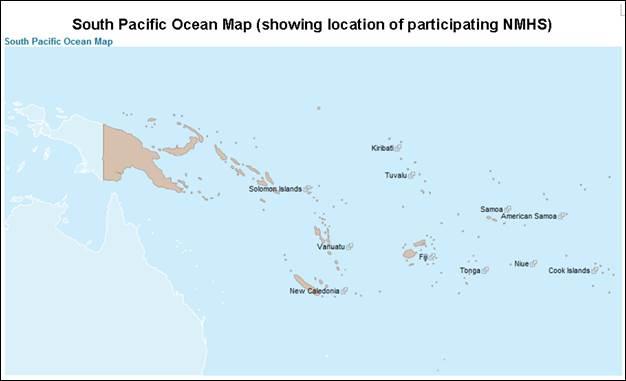SWFP-South Pacific
| Beneficiary Countries/States: | 10 Small Island Developing States in South Pacific: Cook Islands, Fiji, Kiribati, Nauru, Niue, Samoa, Solomon Islands, Tonga, Tuvalu and Vanuatu |
| Regional SWF Centre: |
Other relevant Centres:
|
| Global Centres/WMCs: | |
| Main Focus (Severe weather types): | Heavy rain, strong winds and damaging waves |
| Development Planning inception: | 2009 |
| Present Status: | Phase-IV (sustain operations and continue further development) |
| Download: | Regional Subprogramme Implementation Plan (RSIP) |
| Development Partners/ Donors: |
|
SWFP implementation in South Pacific The SWFP-South Pacific was initiated as 'demonstration project' in 2009. Following decision by the Fifteenth World Meteorological Congress (Cg-XV, 2007), the development planning of a Severe Weather Forecasting and DRR Demonstration Project in RA V was started in 2009 with participation of four Small Island Developing States (SIDS) in South Pacific focusing mainly on heavy rain, strong winds and damaging waves. The contributing global and regional Centres include: Australian BoM, ECMWF, JMA and NCEP/NOAA, RSMC Wellington (lead Regional Centre) and RSMC Nadi (for tropical cyclone forecast support). The first meeting of the Regional Sub-project Management Team (now Regional Sub-programme Management Team) (RSMT) was held in Wellington in April, 2009 to develop the regional subproject implementation plan (RSIP). The RSMT is mainly composed of designated representatives of NMHSs of participating SIDS and contributing global and regional centres. Later, a password-protected RSMC Wellington website and web portal was developed for making available the agreed NWP products and satellite information for the subproject. An in-country preparatory training programme was also stated in October 2009 for capacity development of NMHSs in NWP products' interpretation and use in severe weather forecasting, and in improving delivery of warning services for hydromet hazards. | 
The pilot demonstration phase was started in November, 2009 with participation of four SIDS including Solomon Islands, Vanuatu, Fiji and Samoa. Later, five more SIDS namely: Kiribati, Tuvalu, Tonga, Niue & Cook Islands also joined the subproject and full demonstration phase was commenced in November, 2010 with participation of nine SIDS in the region. The SWFP training activities for Pacific SIDS are meant to develop capacity of the NMHSs on making best use of the available NWP (including ensemble) products and satellite information to improve severe weather and impact-based forecasting and warning services for hazardous weather through engagement of NMHSs with users including disaster management and civil protection authorities (DMCPAs) and media to fulfill their national obligation in reducing risks from meteorological hazards. |
| Year | SWFP-South Pacific: Activities and Milestones since 2009 |
| 2024 |
|
| 2023 |
|
| 2022 |
|
| 2021 |
|
| 2020 |
|
| 2019 |
|
| 2018 |
|
| 2015 |
|
| 2013 |
|
| 2012 |
|
| 2011 |
|
| 2010 |
|
| 2009 |
|
